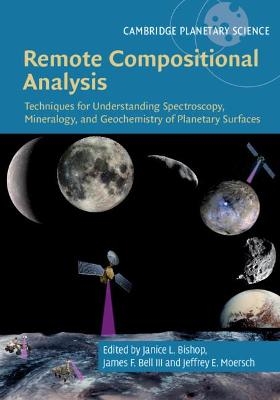
Remote Compositional Analysis
Cambridge University Press (Verlag)
978-1-107-18620-0 (ISBN)
How do planetary scientists analyze and interpret data from laboratory, telescopic, and spacecraft observations of planetary surfaces? What elements, minerals, and volatiles are found on the surfaces of our Solar System's planets, moons, asteroids, and comets? This comprehensive volume answers these topical questions by providing an overview of the theory and techniques of remote compositional analysis of planetary surfaces. Bringing together eminent researchers in Solar System exploration, it describes state-of-the-art results from spectroscopic, mineralogical, and geochemical techniques used to analyze the surfaces of planets, moons, and small bodies. The book introduces the methodology and theoretical background of each technique, and presents the latest advances in space exploration, telescopic and laboratory instrumentation, and major new work in theoretical studies. This engaging volume provides a comprehensive reference on planetary surface composition and mineralogy for advanced students, researchers, and professional scientists.
Janice L. Bishop is a senior research scientist at the SETI Institute, where she is Chair of Astrobiology and on the Science Council. She investigates Mars surface composition, mineral spectroscopy, and volcanic alteration, and has worked with data from many martian missions, including MRO/CRISM for which she is a Co-I. She has served as Editor for Icarus and special issues in American Mineralogist and Clay Minerals. She has received awards from the Clay Minerals Society, the Humboldt Foundation and the Helmholtz Foundation, and is a Geological Society of America (GSA) Fellow. Jim Bell is a professor at Arizona State University, where he specializes in astronomy and planetary science. He studies the geology, geochemistry and mineralogy of Solar System objects using telescopes and spacecraft. He received the Carl Sagan Medal from the American Astronomical Society for excellence in public communication in the planetary sciences, and asteroid 8146 Jimbell was named after him by the IAU. He edited The Martian Surface: Composition, Mineralogy and Physical Properties (Cambridge, 2008) and co-edited Asteroid Rendezvous (Cambridge, 2002). Jeffrey E. Moersch is Professor of Earth and Planetary Sciences at the University of Tennessee. His research focuses on the geology of planetary surfaces, remote sensing, terrestrial analog field work, and planetary instrument development. He has extensive spacecraft mission experience, including work as a member of the science teams of the Mars Exploration Rover mission, the Mars Odyssey mission, and the Mars Science Laboratory mission. He has conducted astrobiology-related research in many terrestrial analog field sites, including Death Valley and the Mojave Desert, the Atacama Desert, the Andes and the Arctic. From 2010 to 2015 he was the Mars Editor for Icarus.
Part I. Theory of Remote Compositional Analysis Techniques and Laboratory Measurements: 1. Electronic spectra of minerals in the visible and near-infrared regions; 2. Theory of reflectance and emittance spectroscopy of geologic materials in the visible and infrared regions; 3. Mid-IR (thermal) emission and reflectance spectroscopy: laboratory spectra of geologic materials; 4. Visible and near-infrared reflectance spectroscopy: laboratory spectra of geologic materials; 5. Visible and infrared spectroscopy of ices, volatiles and organics; 6. Raman spectroscopy: theory and laboratory spectra of geologic materials; 7. Mössbauer spectroscopy: theory and laboratory spectra of geologic materials; 8. Laser-induced breakdown spectroscopy: theory and laboratory spectra of geologic materials; 9. Fundamentals of neutron, X-ray and gamma ray spectroscopy; 10. Radar remote sensing: theory and applications; Part II. Terrestrial Field and Airborne Applications: 11. Visible and near-infrared reflectance spectroscopy: field and airborne measurements; 12. Raman spectroscopy: field measurements; Part III. Analysis Methods: 13. Effects of environmental conditions on spectral measurements; 14. Hyper- and multispectral VNIR imaging analysis; 15. Thermal infrared spectral modeling; 16. Geochemical interpretations using multiple remote datasets; Part IV. Applications to Planetary Surfaces: 17. Spectral analyses of Mercury; 18. Compositional analysis of the Moon from the visible and near-infrared; 19. Spectral analyses of asteroids; 20. VIS-NIR spectral analyses of asteroids and comets from Dawn and Rosetta; 21. Spectral analyses of Saturn's moons using Cassini-VIMS; 22. Spectroscopy of Pluto and its satellites; 23. VSWIR spectral analyses of Mars from orbit using CRISM and OMEGA; 24. Thermal infrared spectral analyses of Mars from orbit using TES and THEMIS; 25. Rover-based thermal infrared remote sensing of Mars using the mini-TES instrument; 26. Compositional and mineralogic analyses of Mars using multispectral imaging on the Mars Exploration Rover, Phoenix, and Mars Science Laboratory Missions; 27. Iron mineralogy, oxidation state, and alteration on Mars from Mössbauer spectroscopy at Gusev Crater and Meridiani Planum; 28. Elemental analyses of Mars using APXS; 29. Elemental analyses of Mars with LIBS by ChemCam and SuperCam; 30. X-ray, gamma-ray, and neutron spectroscopy: planetary missions; 31. Radar remote sensing of planetary bodies.
| Erscheinungsdatum | 02.09.2019 |
|---|---|
| Reihe/Serie | Cambridge Planetary Science |
| Zusatzinfo | Worked examples or Exercises; 147 Plates, color; 14 Halftones, black and white; 18 Line drawings, black and white |
| Verlagsort | Cambridge |
| Sprache | englisch |
| Maße | 177 x 257 mm |
| Gewicht | 1450 g |
| Themenwelt | Naturwissenschaften ► Chemie ► Analytische Chemie |
| Naturwissenschaften ► Geowissenschaften ► Geologie | |
| Naturwissenschaften ► Physik / Astronomie ► Astronomie / Astrophysik | |
| ISBN-10 | 1-107-18620-X / 110718620X |
| ISBN-13 | 978-1-107-18620-0 / 9781107186200 |
| Zustand | Neuware |
| Haben Sie eine Frage zum Produkt? |
aus dem Bereich


